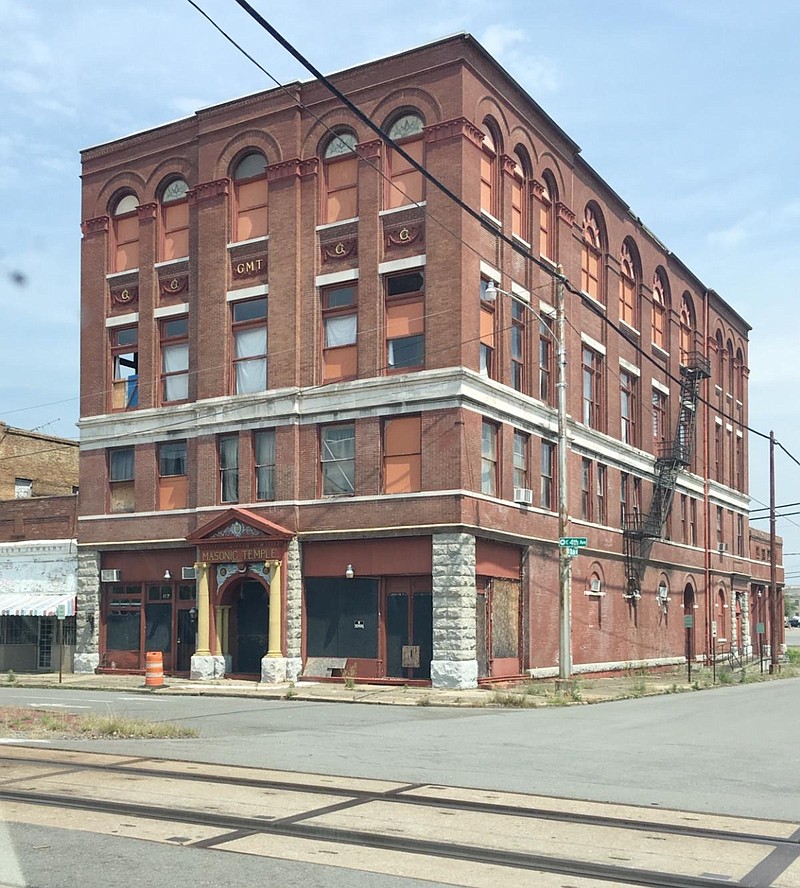The next time you're in downtown Pine Bluff, pause for a moment at the corner of East Fourth Avenue and State Street. Take a good look at the building with the words "Masonic Temple" above the front doors.
From the early 1900s to the 1980s, the Grand Masonic Temple was ground zero for business and commerce for African Americans in Jefferson County and Pine Bluff. The first floor of the building contained retail space.
The second floor contained offices for lawyers, doctors and dentists. In fact, names of well-known African American professionals from that era can still be seen on the doors inside. One is doctor C.E. Hyman, a beloved obstetrician and gynecologist who delivered more than 7,000 babies in his second-floor office.
The upper floors housed offices and meeting facilities for the Sovereign Grand Lodge of Free and Accepted Masons of the State of Arkansas, the state's Black Masonic order. Those meeting facilities also served as a ballroom which entertained some of the best musicians in Blues and Jazz. If you're not familiar with Masonic organizations (and many people aren't these days), a little history will give you some context.
With a history stretching back to stonemasons of the 14th century, Masons are fraternal organizations that work to improve the moral character of their members. The first Black Masonic organization in Arkansas was the J.M. Alexander Lodge No. 4 established at Helena in June 1866 by the Grand Lodge of Missouri. On March 28, 1873, representatives from the three Black Masonic lodges met in Little Rock to form a Grand Lodge of Free and Accepted Masons in Arkansas. By the 1880s, a movement began to construct a Grand Lodge building.
A group headed by Wiley Jones initiated efforts to persuade the Grand Lodge to be located in Pine Bluff. Jones bought two lots on East Second Avenue and presented them to the lodge. Edwin Cook, a local architect, drew plans for a building. When the Grand Lodge met in Pine Bluff in August 1891, after a "stormy session," the organization gave approval to locate the temple in Pine Bluff.
By 1902, the Grand Lodge had accumulated enough money to buy a lot and start the building. On March 24, 1902, the Grand Lodge bought Lot 3, Block 40 of Old Town Pine Bluff for $7,000. Gibbs and Sanders, Little Rock architects, were employed to design the building, and on July 7, 1902, W.S. Helton, a Pine Bluff builder, was given a contract to construct a four-story brick and stone structure.
As part of a Grand Lodge meeting, the cornerstone of the building was laid on August 14, 1902, with elaborate ceremonies that involved local dignitaries as well as officials of the Grand Lodge and the Order of the Eastern Star. When it was completed in 1904, the Masonic lodge was the tallest building in Pine Bluff. It served as the meeting place for the Masons and Order of the Eastern Star and other Masonic houses until 2005.
The Grand Masonic Temple was listed on the National Register of Historic Places in 1978. It is also an African-American Heritage Site. But those designations weren't enough to stop the effects of passing time and changing fortunes.
Today the building sits empty. Doors are shuttered and windows boarded. Local Masons have been considering ways to turn the building into a museum and cultural center. We are hopeful that, like many other historic buildings in Pine Bluff, it will be restored to something approximating its former glory.
This article is among features at ExplorePineBluff.com, a program of the Pine Bluff Advertising and Promotion Commission. Sources: Abandoned Arkansas, Wikipedia, Arkansas Online.
